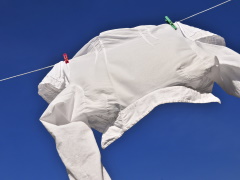Features
Hung out to dry
Date: 2019-07-31 08:44:02.0
Author: Jon Evans

One of the most expensive steps in growing algae as a feedstock for fuels and chemicals is harvesting it, which accounts for up to 40% of the production cost. This is because algae are grown in water at a comparatively low density, and thus need to be extracted from the water and undergo several rounds of dewatering, concentration and drying. Although there are several ways to do this, such as centrifugation and heating, they tend to be fairly energy-intensive and therefore costly.
Now, two research groups have come up with much cheaper alternatives. One involves an advanced material with a range of impressive properties; the other involves a very basic biomaterial with a range of unpleasant properties.
Perhaps the cheapest option is to dry the algae in the sun, as this would be essentially free. Unfortunately, not only is this approach not very efficient, because wet algae tend to reflect much of the sunlight that falls on them, but the algae can also become damaged if they get too hot, potentially ruining their usefulness as a feedstock.
What is needed is a mechanism for enhancing the absorption of sunlight, and the associated evaporation of water from algae, while also preventing the algae from getting too hot. Although these may seem like mutually exclusive goals, a team of scientists from Japan and Germany, led by Yoshikazu Ito at the University of Tsukuba, has found a way to achieve them both, by taking advantage of the atom-thick carbon material known as graphene.
To achieve both these goals, Ito and his team had to combine two slightly different graphene materials. One is a porous nitrogen-doped graphene foam, onto which they deposit a layer of nanoporous nitrogen-doped graphene, to produce a hierarchical graphene structure. The idea is to deposit this structure into a container of algae in water, where it floats on the surface.
The nanoporous nitrogen-doped graphene on top is very effective at absorbing sunlight, causing its surface to heat up. But because both graphane materials are doped with nitrogen, they have a low thermal conductivity, meaning the heat doesn’t travel far. This prevents the algae underneath from getting too hot. At the same time, because the whole graphene structure is porous, water can soak into it and then evaporate from the hot surface, which causes more water to be sucked into the structure. In this way, the water steadily evaporates away as steam, leaving behind the dewatered algae.
As they report in a paper in Advanced Sustainable Systems, when Ito and his team tested this approach on a beaker of algae in water, they found their graphene structure could convert sunlight into steam with an efficiency of 82%. As a result, it evaporated water at a rate of 1.54kg per m2 per hour.
Another inexpensive option for dewatering algae, at least theoretically, is forward osmosis, which takes advantage of the fact that water will naturally flow from a dilute solution to a salty solution via osmosis. So, if you flow algae in water on one side of a membrane and a salty solution on the other, then the water should naturally cross the membrane to the salty solution, thereby dewatering the algae.
This is an inexpensive option provided the salty solution is inexpensive, and now an international team of scientists led by Ho Kyong Shon at the University of Technology Sydney in Australia has found the most inexpensive salty solution possible: human urine. The salinity of fresh urine is fairly high anyway, as it contains a range of inorganic salts including sulfates and phosphates, but this salinity can be more than doubled by simply heating it with water to hydrolyse it.
As they report in a paper in the Journal of Hazardous Materials, Shon and his team found that hydrolysed human urine could draw water from an algae solution at a rate of 14.1L per m2 per hour, causing the algae concentration in the solution to increase by a factor of four. But that’s not all, because, as well as dewatered algae, this process also obviously produces a dilute urine solution, which previous research has shown makes an ideal growth medium for algae.
The views represented here are solely those of the author and do not necessarily represent those of John Wiley and Sons, Ltd. or of the SCI.
This article has not been tagged with keywords.
